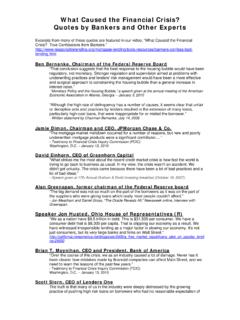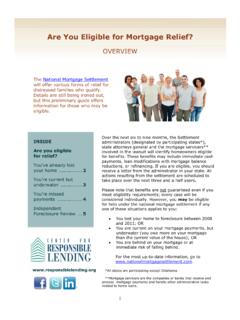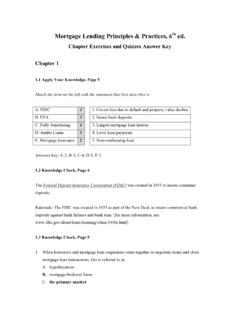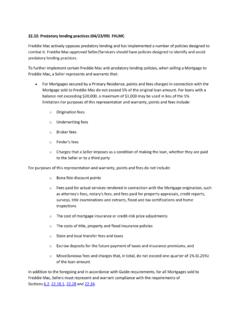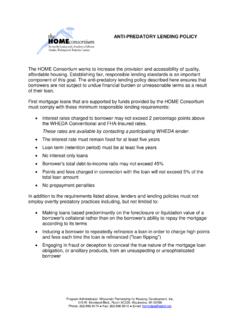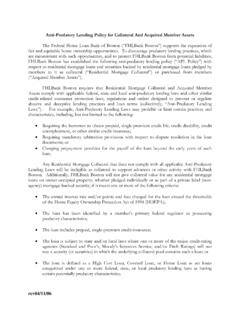Transcription of The Impact of North Carolina's Anti-Predatory Lending Law
1 Quercia, , Stegman, , and Davis, 2003. The Impact of North carolina s Anti-Predatory Lending Law: A Descriptive Assessment. Center for Community Capitalism, University of North carolina at Chapel Hill. THE Impact OF North Carolina's Anti-Predatory Lending LAW: A DESCRIPTIVE ASSESSMENT Roberto G. Quercia Michael A. Stegman Walter R. Davis Center for Community Capitalism The Frank Hawkins Kenan Institute of Private Enterprise CB#3440, The Kenan Center University of North carolina at Chapel Hill Chapel Hill, NC 27599-3440 June 25, 2003 The authors acknowledge receipt of financial support from the Center for Responsible Lending (CRL). However, the views expressed herein are those of the authors and do not necessarily represent the views of CRL.
2 The Impact of North carolina s Anti-Predatory Lending Law: A Descriptive Assessment Center for Community Capitalism 1 Abstract In this study, we examine changes in subprime Lending activity before and after the North carolina Anti-Predatory Lending Law was implemented in 1999 and 2000. Previous studies have noted a decline in overall subprime Lending following the law s enactment. We suggest that such a finding is to be expected given that the purpose of the law was to reduce the number of subprime loan originations with predatory or abusive terms. To us, the relevant question is what component(s) of subprime Lending declined, and which remained stable or increased after the law was implemented. Using an analysis database of million subprime loans covering 1998-2002, supplied to us under license by the company, Loan Performance, Inc.
3 , we find that the reduction in subprime originations observed from 1999 to 2000 is due to a decline in the number of refinance originations, while purchase originations actually increased. Most importantly, we find a large decline in subprime refinance originations with abusive or predatory terms. This is not unexpected since the law s intent was to curtail this type of Lending . Overall, we conclude that after the North carolina predatory Lending law was fully implemented, the subprime market behaved essentially as the law intended: There was a reduction in predatory loans but no change in the cost of subprime credit or reduction in access to credit for high-risk borrowers. The Impact of North carolina s Anti-Predatory Lending Law: A Descriptive Assessment Center for Community Capitalism 2 Introduction The 1990s were characterized by the aggressive expansion of credit to populations traditionally considered underserved, including those with limited or impaired credit histories, such as many minorities and recent immigrants.
4 Financial institutions became more active in this so-called subprime area as a result of technological changes, a robust economy, and the need for new markets. Subprime borrowers have benefited from this expansion of credit, and institutions have seen profits increase through growth (Harvey and Nigro 2002). In fact, subprime mortgage Lending grew significantly over a very short period of time. Across the country, the volume of subprime mortgage originations grew from $35 billion to about $213 billion in only 8 years (1994-2002) (Mortgage Market Statistical Annual 2003). This increase reflects the growing involvement of secondary market institutions such as Fannie Mae and Freddie Mac in securitizing subprime mortgages. Securitized subprime loans increased from $11 billion to $83 billion from 1994 to 1999 (Harvey and Nigro 2002).
5 Subprime Lending serves a wide range of borrowers, from those with minor credit imperfections to those with serious credit problems. In theory, the cost of borrowing increases as the quality of a borrower s credit declines, with the highest fees and rates charged to borrowers with the lowest credit quality. Problems may arise if unscrupulous lenders take advantage of uninformed The Impact of North carolina s Anti-Predatory Lending Law: A Descriptive Assessment Center for Community Capitalism 3 borrowers by charging fees and rates not reflective of the risk, by not informing borrowers of their least expensive loan alternatives, and by offering products and services without full disclosure of terms and options. The term predatory Lending refers to a set of abusive Lending practices concentrated in the subprime sector.
6 These include making unaffordable loans based on the assets of the borrower rather than on the borrower s ability to repay an obligation; inducing a borrower to refinance a loan, often repeatedly, in order to charge high points and fees on the refinance ( loan flipping ); and engaging in fraud and deception to conceal from an unsuspecting or unsophisticated borrower the true nature of the loan obligation (Gramlich 2000). For service providers, regulators, and legislators, dealing with predatory Lending requires a balancing act, because curbing these practices may curtail credit to some borrowers. Some borrowers may be so uncreditworthy that they can only get credit under conditions that are considered predatory . Historically, however, government has acted to curb abusive Lending practices even if the regulations limit the flow of certain kinds of credit.
7 predatory Lending can have a devastating effect on families. Loans made without regard to a borrower s repayment ability are likely to erode the borrower s home equity position. This is especially true for minority and low-income families, for whom home equity comprises over 60 percent of their net worth (State of the Nation s Housing 2002). In addition, most older The Impact of North carolina s Anti-Predatory Lending Law: A Descriptive Assessment Center for Community Capitalism 4 homeowners depend on equity to supplement other savings after retirement (Quercia 1997). The importance of home equity for these financially unsophisticated or vulnerable populations makes them potential targets of predatory practices (Carr and Kolluri 2001). In the absence of direct evidence, and because predatory Lending is largely a subset of subprime Lending , the potential for abuse can be deduced by observing overall subprime Lending patterns and changes over time.
8 For instance, subprime loans are three times more likely in low-income neighborhoods than in high-income neighborhoods and five times more likely in black neighborhoods than in white ones. Furthermore, homeowners in high-income black areas are twice as likely as homeowners in low-income white areas to have subprime loans. Similarly, subprime loans are three times more likely among older borrowers than among younger borrowers (AARP 2003). These figures suggest that the negative impacts of abusive or predatory subprime practices may fall most heavily on those who have less access to prime credit (HUD 2000). Unfortunately, there is no single, agreed-upon definition of what constitutes predatory Lending . Those that exist are largely based on the definition of high-cost loans in the federal Home Ownership and Equity Protection Act (HOEPA) of 1994, which bans certain practices and requires additional disclosures and borrower protections.
9 In 2000, about one percent of all subprime mortgage loans was estimated to fall under HOEPA (Gramlich The Impact of North carolina s Anti-Predatory Lending Law: A Descriptive Assessment Center for Community Capitalism 5 2000).1 By contrast, estimates of predatory Lending and actual settlements entered into by large subprime lenders suggest the true incidence may be considerably higher (for example, see Richardson 2003). Since 1994, several states and local jurisdictions have enacted HOEPA-like regulations and ordinances, so that high-cost or predatory loans have come to be defined as loans featuring one or more specified terms and underwriting practices, including exorbitant points and fees, balloon payments, prepayment penalties, loan flipping, as well as not requiring adequate documentation of repayment ability, and including interest rates on real estate-secured loans in and above the credit card range.
10 Critics have questioned whether legislative efforts to curb predatory practices would also increase the cost of serving particular segments of the market, reduce the supply of mortgage credit and raise the cost of borrowing (Elliehausen and Staten 2002 and 2003). Because North carolina was the first state to enact Anti-Predatory legislation, its 1999 Anti-Predatory Law has received a great deal of attention. Examinations of the law s Impact to date have had varied results. This study is the first in a series to be prepared by the Center for Community Capitalism, a research center based in the Kenan Institute of Private Enterprise in the University of North carolina at Chapel Hill, on the 1 In 2002, revisions to Regulation Z (Truth in Lending act) expanded the definition of high-cost loans under HOEPA.



